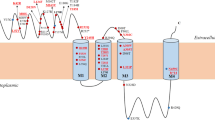Abstract
Juvenile myoclonic epilepsy (JME) is a genetically determined common subtype of idiopathic generalized epilepsy. Linkage of JME to the chromosomal region 6p21.3 has been reported. An association has been previously observed between JME and the positional candidate, 6p21.3 linked, BRD2. Another candidate in this region is the TAP-1 gene encoding the Transporter Associated with Antigen Processing. The aim of the present study is to determine whether these two genes modulate the vulnerability to JME. While no difference was observed in the allele and genotype frequencies of BRD2 between JME and controls, an association was found between a TAP-1 haplotype and JME, suggesting that this gene may be another 6p21.3 linked vulnerability factor to JME.
Similar content being viewed by others
References
Janz D (1985) Epilepsy with impulsive petit mal (juvenile myoclonic epilepsy). Acta Neurol Scand 72:442–452
Dreifuss FE (1989) Juvenile myoclonic epilepsy: characteristics of a primary generalized epilepsy. Epilepsia 30(Suppl 4):S1–S7
Grünewald RA, Panayiotopoulos CP (1993) Juvenile myoclonic epilepsy. Arch Neurol 50:597–598
Turnbull J, Lohi H, Kearney JA et al (2005) Sacred disease secrets revealed: the genetics of human epilepsy. Hum Mol Genet 14(Spec 2):2491–2500
Delgado-Escueta A (2007) Advances in genetics of juvenile myoclonic epilepsies. Epilepsy Cur 7(3):61–67
Greenberg DA, Delgado-Escueta AV, Widelitz H et al (1988) Juvenile myoclonic epilepsy (JME) may be linked to the BF and HLA loci on human chromosome 6. Am J Med Genet 31:185–192
Pal DK, Evgrafov OV, Tabares P (2003) BRD2 (RING3) is a probable major susceptibility gene for common juvenile myoclonic epilepsy. Am J Hum Genet 73(2):261–270
Greenberg DA, Durner M, Keddache M et al (2000) Reproducibility and complications in gene searches: linkage on chromosome 6, heterogeneity, association, and maternal inheritance in juvenile myoclonic epilepsy. Am J Human Genet 66:508–516
Lorenz S, Kirsten PT, Gehrmann A et al (2006) Association of BRD2 polymorphisms with photoparoxysmal response. Neurosci Lett 400:135–139
de Kovel CG, Pinto D, de Haan GJ (2007) Association analysis of BRD2 (RING3) and epilepsy in a Dutch population. Epilepsia 48(11):2191–2192
Cavalleri GL, Walley NM, Soranzo N et al (2007) A multicenter study of BRD2 as a risk factor for juvenile myoclonic epilepsy. Epilepsia 48:706–712
van Endert PM, Lopez MT, Patel SD et al (1992) Genomic polymorphism, recombination, and linkage disequilibrium in human major histocompatibility complexencoded antigen-processing genes. Proc Nat Acad Sci USA 89:11594–11597
Colonna M, Bresnahan M, Bahram S et al (1992) Allelic variants of the human putative peptide transporter involved in antigen processing. Proc Natl Acad Sci USA 89:3932–3936
Powis S, Tonks S, Mokridge I et al (1993) Alleles and haplotypes of the MHC-encoded ABC transporters TAP1 and TAP2. Immunogenetics 37:373–380
Powis S, Rosenberg W, Hall M et al (1993) TAP1 and TAP2 polymorphism in celiac disease. Immunogenetics 38:345–350
Shi L, Yang G, Fu Y et al (1997) Human TAP1 polymorphisms detected by denaturing gradient gel electrophoresis. Tissue Antigens 49:421–426
Tang J, Freedman DO, Allen S et al (2001) TAP1 polymorphisms in several human ethnic groups: characteristics, evolution, and genotyping strategies. Hum Immun 62:256–268
Lajoie J, Zijenah LS, Faucher MC et al (2003) Novel TAP1 polymorphisms in indigenous Zimbabweans: their potential implications on TAP function and in human diseases. Hum Immun 64:823–829
Jackson DG, Capra JD (1993) TAP1 alleles in insulin-dependent diabetes mellitus: a newly defined centromeric boundary of disease susceptibility. Proc Nat Acad Sci USA 90:11079–11083
O’Connell MA, Harvey AS, Mackay MT, Cameron FJ (2008) Does epilepsy occur more frequently in children with type 1 diabetes? J Paediatr Child Health 44(10):586–589
Guipponi M, Thomas P, Girard-Reydet C et al (1997) Lack of association between juvenile myoclonic epilepsy and GABRA5 and GABRB3 genes. Am J Med Genet B Neuropsychiatr Genetics 74(2):150–153
Commission On Classification And Terminology of The International League against Epilepsy (1989) Proposal for revised clinical and electroencephalographic classification of epileptic seizures. Epilepsia 30:389–399
Stephens M, Smith N, Donnelly P (2001) A new statistical method for haplotype reconstruction from population data. Am J Human Genet 68:978–989
Barrett JC, Fry B, Maller J, Daly MJ (2005) Haploview: analysis and visualization of LD and haplotype maps. Bioinformatics 21:263–265
Acknowledgments
This study was supported by the University Hospital of Geneva and the Swiss Telethon Foundation (to A.M.).
Author information
Authors and Affiliations
Corresponding author
Rights and permissions
About this article
Cite this article
Layouni, S., Buresi, C., Thomas, P. et al. BRD2 and TAP-1 genes and juvenile myoclonic epilepsy. Neurol Sci 31, 53–56 (2010). https://doi.org/10.1007/s10072-009-0190-z
Received:
Accepted:
Published:
Issue Date:
DOI: https://doi.org/10.1007/s10072-009-0190-z




